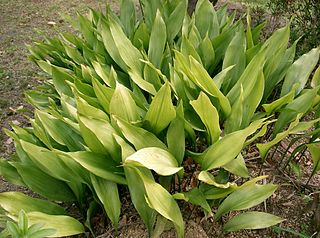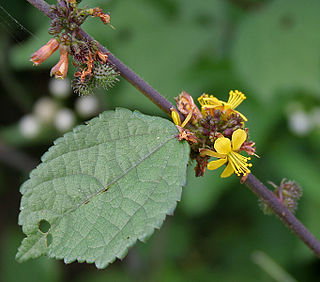
Magnolia is a large genus of about 210 flowering plant species in the subfamily Magnolioideae of the family Magnoliaceae. It is named after French botanist Pierre Magnol.

Aspidistra is a genus of flowering plants in the family Asparagaceae, subfamily Nolinoideae, native to eastern and southeastern Asia, particularly China and Vietnam. They grow in shade under trees and shrubs. Their leaves arise more or less directly from ground level, where their flowers also appear. The number of species known has increased considerably from the 1980s onwards, with around 100 accepted as of July 2013. Aspidistra elatior is common worldwide as a foliage house plant that is very tolerant of neglect. It and other species can also be grown in shade outside, where they are generally hardy to −5 °C (23 °F).

Vallisneria is a genus of freshwater aquatic plant, commonly called eelgrass, tape grass or vallis. The genus is widely distributed in tropical and subtropical regions of Asia, Africa, Europe, and North America.

Piranhea is a plant genus under the family Picrodendraceae described as a genus in 1866.

Rohdea is a genus of plants native to eastern Asia. It was long thought to contain only a single species, R. japonica, but recent studies have resulted in several other taxa being transferred into the genus.

Portulacaria is a genus of succulent plant, classified in its own subfamily Portulacarioideae in the family Didiereaceae. It is indigenous to southern Africa.

Gymnema is a genus in the family Apocynaceae first described as a genus in 1810.

Callitriche is a genus of largely aquatic plants known as water-starwort. Previously, it was the only genus in the family Callitrichaceae. However, according to the APG II system this family is now included in the Plantaginaceae. The family name Callitrichaceae retains its status as nomen conservandum.
Myriactis is a genus of flowering plants in the aster tribe within the sunflower family.

Kadsura is a genus of woody vines in the Schisandraceae described as a genus in 1810.

Triumfetta is a genus of plants in the family Malvaceae. Burbark is a common name for plants in this genus.
Kadsura longipedunculata, also known as the Chinese Kadsura Vine, is a fruit bearing monoecious wild evergreen climbing shrub, that is native to Eastern Asia, Western China and Southern China.This rare and unknown flower is often used for its medicinal properties in Asia.

Pentanisia is a genus of flowering plants in the family Rubiaceae.

Securidaca longipedunculata is a species of tree in the genus Securidaca. It is most commonly found in the tropical and subtropical areas of Africa, and it was given protected status in South Africa. The generic name is derived from Latin securis, as the shape of the wing on the nut recalls a hatchet. The specific name longipedunculata hints at the long peduncle on which the flowers are borne.

Schistogyne is a genus of flowering plants of the family Apocynaceae, first described as a genus in 1810. It is native to South America.
Bocagea is a genus of plants in the family Annonaceae. It comprises four species distributed in Brazil. Augustin Saint-Hilaire the French botanist who first formally described the genus named it after Josephi Mariae de Souza du Bocage, who he said beautifully translated a poem about flowers into Portuguese and illustrated it.
Centemoposis is a genus of plants in the amaranth family, Amaranthaceae and is found in Africa distributed from Tropical Africa to South Africa.
Etlingera velutina is a monocotyledonous plant species first described by Henry Nicholas Ridley, and given its current name by Rosemary Margaret Smith. Etlingera velutina is a member of the genus Etlingera and the family Zingiberaceae.

Coussapoa is a genus of flowering plants belonging to the family Urticaceae.













